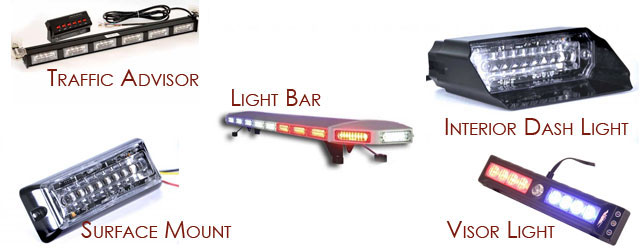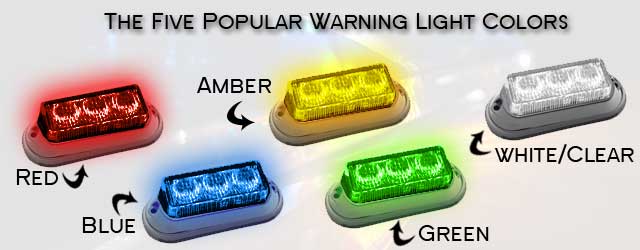Emergency Vehicle Light Mount Types and Color Choices
First responders must make sure their fleet vehicles have the right type of gear to be seen from near and far. The first warnings of first responder traffic are flashing beams in the distance. Without emergency lights, there would be no way to warn drivers that rescue was on its way. Not having the ability to move traffic could slow response time and make calls more dangerous. It's also vital this gear is installed in the proper locations and adheres to state laws. Here we will go over:
- How to choose the right lights for your vehicle
- How to achieve rear and front facing light
- Brief description of warning light colors.
The Importance of Understanding Emergency Vehicle Light State Statutes
It’s important for first responders to have proper lights and sirens on their vehicles. Fleet managers, drivers, and outfitters need to know their state’s emergency vehicle light statutes. Laws regarding this type of equipment vary from state to state and are enforced by police.
Different Types of Emergency Vehicle Lights
 Almost any kind of light can be purchased with LED, halogen, or strobe bulbs. The type of technology chosen is determined by budget, visibility requirements, and preference. No matter what technology is chosen, the mounting locations are relatively the same.
Almost any kind of light can be purchased with LED, halogen, or strobe bulbs. The type of technology chosen is determined by budget, visibility requirements, and preference. No matter what technology is chosen, the mounting locations are relatively the same.
Emergency lights need to be mounted on various parts of a vehicle so the gear can be seen from all directions. The most well-known equipment is the light bar. Light bars are available as full-size models, mini models, and even stealth, low-profile units. Many departments and volunteers install light bars on the rooftops of vehicles to provide 360 degrees of output. For those installing rear and front facing units to achieve all-around visibility, there is a variety of options other than a full-size bar.
Front Facing Emergency Light Choices
You can avoid paying the high cost of a full-size LED light bar when you install front facing and rear facing units. The best front facing emergency lighting options include:
- Interior Light Bars
- Visor Lights
- Dash Lights
- Grille & Surface Mount Lights
- Hideaway LEDs & Strobe Kits
Rear Facing Emergency Light Choices
Many fleet managers make the mistake of concentrating on the front of an emergency vehicle and forget about the rear. First responder vehicles are prone to rear-end collisions. By increasing the visibility of a vehicle’s rear end, you decrease the risk of a rear-end collision. The best types of equipment to add to the rear of a vehicle include:
- Traffic Advisors
- Surface Mount Lights
- Hideaways
- Bumper Lights
- Strobe Kits
Install Front Facing or Rear Facing Emergency Lighting in the Appropriate Locations
Ensuring lights are mounted correctly will help keep first responder personnel and the public safe. Whether you are installing front facing or rear facing lighting, you need to make sure you choose the proper mount locations. It’s also vital to have the lights wired and installed correctly for proper use.
When purchasing units, you will want to consider whether the lights are made for exterior or interior use. It’s important to note that not all lights are made for use on the outside of a vehicle. The way to tell the difference is to see if the gear is weatherproofed. Weatherproofed units are sealed to keep moisture out and can be installed on the exterior or interior. If a unit is not weatherproofed, it cannot be used on the exterior because moisture will absorb into the device and cause it to malfunction.
Emergency Vehicle Light Color Choices

The most common color choices for first responders in the US are red, blue, white, green, and amber. State statutes determine what departments can use these colors. Some statutes also dictate where the lights can be mounted on a vehicle.
Red is the most common color used to denote an emergency situation. Red lights are mounted on fire trucks, police vehicles, and rescue squad vehicles. When in a combination split light, red is often paired with blue or white.
Blue: Police and other law enforcement vehicles typically use blue lights or a combination of blue and red illumination. Volunteer firefighters and rescue squad members in some states may also use blue lights in their private vehicles when they're deploying to the firehouse or squad building in response to an emergency. In addition to a red and blue color combination, many state statutes allow first responder units to use blue/white color combinations.
Yellow or Amber: Construction vehicles in many states use amber lighting to signify caution, often because these vehicles move slower than traffic or sometimes block traffic completely. Tow trucks and security patrols may also use yellow/amber units. Snowplows and other municipal service vehicles use yellow warning lights. Rescue squad vehicles sometimes combine red and yellow emergency lighting. School buses use both amber and red lights to notify approaching traffic to slow or stop when a school bus is loading or unloading.
Green: In some states a green emergency light will indicate a mobile command post, a fire chief's car or a volunteer firefighter's vehicle. In the United States, green lighting is also used by Homeland Security, and some private security agencies that are contracted to patrol government buildings.
White: A school bus or tanker truck for fueling will often use a flashing white light.
Extreme Tactical Dynamics offers LED lights for every inch of a first responder vehicle. Get 360-degrees of visibility at affordable prices when you shop our online store. We always have more than one led light bar for sale, along with a full assortment of emergency vehicle lighting and police siren equipment.
 Facebook
Twitter
Google+
Instagram
YouTube
Facebook
Twitter
Google+
Instagram
YouTube


